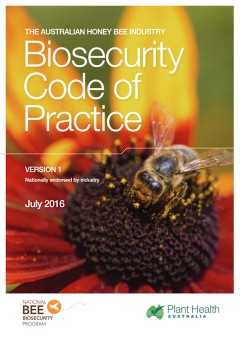Session 1 - A Reality Check
Welcome to Apis Mellifera Training. The first Session is a Reality Check, enabling potential Beekeepers to make an informed decision whether or not to take up Beekeeping. This session elaborates on Beekeeping Rules and Regulations, Legal obligations for the beekeeper, Beekeeper Registration, cost estimates.
Beekeeping can be a fulfilling and rewarding experience, but it's not all sunshine and honey. It takes patience, dedication and hard work to maintain a healthy and thriving hive. So let's get stuck in and learn whether beekeeping is the right choice for you!
Session 1 Table of Contents
Registration, Biosecurity, Agriculture Victoria
109 The Victorian Apiary Code of Practice
Provision of water, Hive location, Hive Density, etc.
Agriculture Victoria
Legal Obligations of Beekeepers
Legal Obligations of Beekeepers
online registration
100a Knowledge about Bees and Beekeeping
When asking five beekeepers a question about bees or beekeeping you often get five different answers - and all have their reasoning to support the answers.
And not one answer has ever been confirmed by bees as we can't ask bees a question in a way they understand, nor do we understand what they are telling us.
An element of speculation has historically been part of our knowledge about bees and always will be. Through observation, research and communication between beekeepers our knowledge is getting better over time.
What we nowadays know about bees is different to what it was hundred years ago, and in hundred years from now our knowledge about bees will hopefully be better again.
It could also be wrong assuming that the knowledge of a beekeeper who has kept bees for over fifty years is better, compared with someone who is into it for only a few years.
Whilst the practical experience plays an important part, it also depends on how much time and effort you invest to update your knowledge, along with an open mind to accept new discoveries made.
100b Motivation the Driver for Beekeeping
A commercial beekeeper with 1,000 or more beehives has a different perspective on beekeeping compared to a hobby beekeeper with two hives in the backyard. What is right or important for one beekeeper might not be relevant for another and is not necessarily in the best interest of the bees.
Whatever the motivation is for keeping bees, it can only be sustainable when it has benefits for both, the bees and the beekeeper.
Commercial gain can be a motivation, although when maximising honey yield the approach to beekeeping is different as when maximising pollination contracts, and different again when rearing and selling queen bees.
Some beekeepers might keep a few hives in an apple orchard to improve crop yield as the main reason but don't interact with the bees otherwise.
Some others might keep a beehive in the backyard with the aim to harvest some honey at the end of the season without any significant interaction with the bees.
Someone might want to keep a hive of very friendly bees in the backyard to introduce the kids or grand kids to the wonders of nature, watching and observing them regularly and closely, outside and inside the hive and maybe getting some honey every now and then as a bonus.
My motivation is driven by the fascination for these amazing little creatures, interacting with and caring for each of my hives and providing them with a healthy environment in which they can grow and prosper, supporting them with the best of my abilities with their challenge to survive our "modern way of life".
How we interact with bees can either help or work against them.
100c Bees are adaptable are they?
Bees cannot adapt to everything we do to them and the environment.
The relationships bees and humans have with the environment are different:
- Bees are trying to adapt to the changing environment and the conditions we humans create for them by our civilisation.
- We humans are trying to change or improve our conditions and maybe unwillingly, as a side effect, negatively impact the environment and conditions not only for the bees but other life forms, including ourselves.
- We have introduced mono culture farming on a large scale, treat the farming soil with chemical products, apply a range of toxic chemicals against plant diseases and pests etc. Using a weed killer introduces toxic substances into the waterways with the next rain. There are hundreds of "approved" products which are more or less toxic on its own and have an uncontrolled negative impact on the environment when used in combination, knowingly or unknowingly. . .
101 Some Questions
Think about it and answer it for yourself
1. Why do you want to keep bees?
2. Have you ever been stung by a bee?
3. Are you allergic to bee stings?
4. Is someone you are living with allergic to bee stings?
5. Are you prepared to care for your bees?
when they need it, not just when you feel like it,
or when you can fit it into your schedule.
Even when you don’t get any honey in return?
102 Your desire? - You will get stung
So, You have the desire to keep bees
but maybe:
- you are not so sure whether it is the right thing for you.
- there might be a good reason why you should not keep bees.
- your desire for keeping bees is based on a romantic motion.
Please confirm your desire after applying the reality check.
Will I get stung?
Be assured - YOU WILL

When I started beekeeping the bees must have disliked my approach or sensed my fear for bee stings and I got my fair share of it. After years of learning I nowadays approach my bees with calm and without thinking about bee stings. As a result, the bees stay calm too and I'm rarely getting stung and if I am it does not bother me much.
103 Why keeping Bees?
1. Harvesting your own honey from your own backyard, produced by your own bees, is the main reason why many beekeepers find their hobby rewarding.
2. Pollinating the fruit trees and vegetables grown in your garden is probably the second common reason for keeping bees.
3. Helping the environment can be another reason. Most of the fruit and vegetables we eat are pollinated by bees. Without bees and their hard work, many crops struggle and some would disappear.
4. Many beekeepers find their activity helps them relax from the stress of daily modern life. The slower pace that needs to be adopted when around bees transitions the beekeeper in a much more relaxed space.
5. If you want to keep bees to make money you are probably on the wrong track. When you weigh up the time and work involved and the return, please be assured - this is definitely not an easy way to make money.
So, don't quit your job! Not as yet.
104 Why not keeping Bees?
You should not keep bees:
- when you or someone living with you is allergic to bee stings.
- when you cannot look after your bees when required and
not just when it suits you, or you think of it, or you feel like it!
Although bees are wild animals and in the wild look after themselves, when kept in urban areas they need to be managed by a knowledgeable beekeeper, practising responsible hive management and swarm control.
It is your obligation as a beekeeper that your bees and hives are managed regularly and responsibly.
Tip: It might result in many more bee stings when you are hectic or inpatient around bees. Fast movements aggravate bees.
105 Irresponsible Beekeeping
Examples of irresponsible beekeeping:
1. Placing one or more beehives in your backyard, orchard or on your land and leaving them to themselves, never open the hive to assess their needs and health status, is irresponsible beekeeping.
2. Setting up the hive, separating the brood box below from the honey box on top with a queen excluder, and every now and then only open the top box to harvest some honey, never care to check the brood box, is irresponsible beekeeping.
3. Setting up a "Flow Hive" and every now and then only open the tap to harvest some honey, never care to check the brood box, is irresponsible beekeeping.
You cannot call yourself a beekeeper when you don’t manage your hives!
106 Unmanaged Hives - Irresponsible Beekeeping
Undesirable side effects of unmanaged Hives:
1. You and your neighbourhood will be blessed every spring and summer with swarms emerging from your unmanaged hives; usually one swarm per hive every year!
2. If you are not capturing your swarms in your neighbourhood who is going to bear the cost of having them removed and the potential damage caused ? Imagine the trouble and cost of having bees removed out of the floor cavity between the two levels of a double storey building.
3. Keeping bees without providing a reliable source of water forces them to fetch water from your neighbours’ backyard, e.g. a swimming pool, potentially stinging the pool users. What if someone is allergic?
4. Potential bee diseases in unmanaged hives will not be taken care of and might spread to other bee colonies in the area.
You cannot call yourself a beekeeper when you don’t manage your hives!
107 Convincing your Neighbours
One of the biggest challenges in backyard beekeeping is convincing your neighbours that they are safe even when having a beehive nearby.
Unless your neighbours are fine with your idea of keeping bees nearby, you won't get any peace as a beekeeper.
Instead of risking your good relations with your neighbours, following a few rules can establish rapport with your neighbours in light of your new-found hobby.
Do not place more than one or two hives in your backyard.
The presence of three or more hives on an average suburbian block can draw fire from neighbours who do not understand that bees, unless disturbed, are really very gentle insects.
If you want to take care of more than one or two colonies of honeybees find a suitable large block of land nearby and ask the land owners if you can place a few hives on their property.
In most cases farm owners will agree to your idea because farmers know just how important pollination is to crop production. Your honeybees will be more than welcome to stay on farms.
One of the things you can do before setting up a hive with honeybees is, installing a tall enough fence for your new bee yard. Apart from reducing the visibility of your yard, tall fences also force honeybees to fly at a certain height. You wouldn't want them flying below the height of an average person. People might think the bees are after them.
The Victorian Apiary Code of Practice specifies rules and regulations in order to minimise the risk of conflict between people and honeybees.
As a considerate beekeeper you should stick to the rules to avoid conflict with your neighbours and the council.
107a Note on Rules and Regulations
Rules and regulations are published by various Australian departments and organisations; links and references are provided in Session 1. Regulations are valid for Australia but as they are based on common sense they should be applicable to other locations in one form or another.
108 Rules and Regulations for Victoria
When getting started as a beekeeper you need to familiarise with the rules, regulations and obligations associated with beekeeping. Responsible beekeeping is not simply a matter of hosting Beehives in your backyard.
1. If you want to keep one or more hives of bees in Victoria you must to:
Register as a beekeeper - Registration must be renewed every 24 months.Registering as a new Beekeeper or renewing your registration can be done on the Agriculture Victoria website.
2. Beekeepers also need to comply to Beekeeping Rules and Regulations
click on picture to download
The rules, regulations and best practices associated with beekeeping are not difficult to understand and follow, they can be found in several booklets or on the following websites:
2.1 The Australian Honey Bee Industry Biosecurity Code of Practice The Code incorporates fundamental biosecurity principles into the practices of all Australian beekeepers. The Code can be downloaded from this website as pdf file. This website also provides links to other related subjects and websites;
2.2 The Victorian Apiary Code of Practice, May 2011 can be downloaded from this website as pdf file.2.3. Regulations and best practices defined on the website of Agriculture Victoria
The Agriculture Victoria website holds more information and provides links to a number of important topics.
For more information please explore the Agriculture Victoria website.
109 The Victorian Apiary Code of Practice
click on picture to download
These Guidelines for beekeepers cover topics like:
Management of Apiaries
Swarming (Control and Collection)Provision of waterDocile beesStorage of spare equipmentRobbing beesFlight pathsTransportation of hivesUse of smoke by apiaristsStatutory Planning Requirements
Hive locationHive Density- - - The following subjects in more detail - - -
4.3 Provision of waterIf honey bees do not have access to water, the beekeeper must provide it on the property on which the hives are managed.This water must be placed, where possible, in a partially shaded position in close proximity to the hives. (5 - 20 metres)It is necessary to place this water in position before or as the hives are brought on to the property. This helps the bees to orientate to this water before they look for other sources elsewhere; e.g. neighbour's swimming pool.To allow the bees to alight and drink, water containers should include suitable floating material, or stones, bricks or sand to provide a beach effect if using a shallow pan.The use of Boardman feeders for water supply in urban areas is encouraged.5.1.2 Hive Location in Urban areasHives can be kept within 3 metres of a boundary fence if:
- the height of the solid fence is more than 2 metres.
- on the adjoining property to the fence, a building of not less than 2 metres high is constructed on the fence line immediately adjacent to the hives which has no window or other openings in the elevation on the fence line.
- the adjoining property to that fence is unimproved land.
- an impenetrable vegetative barrier (such as a hedge) not less than 2 metres high is located on the property boundary adjacent to the hives.
If the above conditions cannot be met, the minimum distance hives can be kept from a fence is 3 metres.If a bee flight-path interferes with the use of neighbouring land a bee proof barrier, such as trees, hedge, fence or building must be present,5.1.1 Hive Density in Urban areasOne of the primary limitations on beekeeping is the real or perceived interaction between bees and people who live in or use areas near hives. In conjunction with management practices outlined in the Apiary Code of Practice, hive density limits are set to minimise the risk of conflict between people and honey bees. The table below indicates the maximum hive number per tenement.
Tenement size metric | Tenement size in acres | Hive Limit |
500 m² or less | 1 | |
501 m² to 1000 m² | 2 | |
1001 m² to 2000 m² | 5 | |
2001 m² to less than 4000 m² | 0.49 to 0.99 | 10 |
4000 m² to less than 1 ha | 1.0 to 2.47 | 60 |
1 ha to 2 ha | 2.48 to 4.94 | 100 |
Larger than 2 ha | Larger than 4.94 | no limit |
How many hives you are allowed to keep on your property in Victoria depends on the land size as specified above.
However, where a beekeeper has undertaken swarm collection and a need for temporary storage of swarms is required on a tenement which possesses a density control, such control can be exceeded for a maximum of 14 days after which the density control must be observed.
In any other instance which does not conform with the above dispensations a planning permit is required for the keeping of bees where it is proposed to exceed hive densities.
- - - Refer to the Victorian Apiary Code of Practice for more information - - -
110 Legal obligations of beekeepers
formerly known as AG1100
The Agriculture Victoria website presents the publication Legal obligations of beekeepers, covering topics such as:
- Registration of beekeepers
- Registration fee
- Certificate of registration
- Renewal of registration
- Cancellation of registration
- Construction of hives
- Branding hives
- Disposal of hives
- Disease and exposure of bees to infected hives and equipment
- Access of bees to honey
- Notification of bee disease
- Direction to attend at hives
- Cleanup of disease outbreaks
- Abandoned and neglected hives
- Introduction of bees, hives, used hive equipment and bee products into Victoria
- Honey Bee Compensation and Industry Development Fund
- Apicultural Industry Advisory Committee
- Penalties
- Apiary inspectors
111 Construction of hives
Legal obligations of beekeepers
Good beekeeping practices include regular inspections of brood and honey combs in all hives for honey bee diseases and pests. Proper inspections are impossible when hives do not have beeswax combs held within movable frames.
The Act requires beekeepers to only keep hives that have easily and individually removable frames. Top bar hives may be kept, provided the combs can be individually removed from the hive for inspection without cutting or tearing.
In cases where hives don't contain movable frames, the Act empowers DJPR apiary inspectors to order beekeepers to transfer the combs to movable frames or destroy the bees.
The Act does not stipulate dimensions for hives and frames. However, almost all beekeepers in Victoria use the 8- or 10-frame Langstroth full-depth hive.
112 Branding hives
Legal obligations of beekeepers
All hives must be marked or branded with the beekeeper's registered number (brand) that is printed on the Certificate of Registration. Branding of hives enables DJPR apiary inspectors to identify the owners of hives and notify them of disease, vandalism, theft and other problems.
The letter and figures of the brand may be painted, stencilled, stamped, carved or fire branded (burnt) onto the hive. The letter and figures must be readable at all times and must not be less than 19 mm high. The brand is usually placed under the handhold at both ends of the box.
The Act does not require all hive components to be branded, but most beekeepers prefer to do so, including top bars of frames, as this helps to prevent theft.
Anyone who obtains a hive must:
- cancel the brand of the previous owner by placing a mark over the brand number on the hive
- place his or her own brand on the hive.
This must be done within 28 days of acquiring the hive. It is illegal for a registered beekeeper to have a hive not branded with his or her registered brand number.
However, it is legal for a beekeeper to have a hive branded with another registered beekeeper's brand provided he or she has the permission of that registered beekeeper.
Please familiarise yourself with the
113 Before acquiring any Bees
Before spending time and money setting up one or several hives it might be wise to think about a few things.
Are you or someone living with you allergic to bee stings?
When was the last time you have been stung by a bee?
When taking up beekeeping there should be no doubt that you will get stung by bees!
If you have not recently been stung by a bee and don’t know how your body reacts, consult your doctor before you approach a beehive.
Keeping bees does not guarantee the yield of honey every year.
Are you prepared to look after your bees when they need it and without getting any honey in return?
Rather than harvesting honey, in some years you might end up feeding your bees instead.
There have been cases where new beekeepers with great enthusiasm have set up several hives, only to discover along the track that they could not stand their body's reaction to bee stings. With great disappointment, less than a year after they started beekeeping, they sold their hives and equipment and gave it up.
To reach certainty about your new undertaking, make contact with a beekeeper to visit, dive into a bee suit and experience hands-on if this is something you really want to do - before acquiring any bees. You might be able to hire a hive to try it out.
The next step towards beekeeping is to start with one, or better two beehives. Find out your body's reaction after one year of bee sting encounters - in most cases the body builds up an immune system and the reaction is hardly felt.
If your body's reaction after bee stings becomes more and more severe you probably should not pursue beekeeping any further. You can get desensitised though.
Swelling and itchiness of my cheek, neck and chest for almost a week was the reaction to my first bee sting to my cheek after I started beekeeping.

These days I don’t react to bee stings anymore - Lucky me!
Be aware:
Before getting started as a beekeeper you need to be familiar with the rules, regulations and obligations associated with beekeeping.
Beekeepers in Victoria must be registered with the Department of Jobs, Precincts and Region (DJPR) of Victoria. Registration is free for up to five hives when you register online and costs $15 per annum for up to 50 hives. Registration must be renewed every 24 months.
Usually, in particular during swarming season, you will need to schedule your activities according to your bees’ needs and in conjunction with the weather, rather than your own wishes.
To get started as a hobby beekeeper you are looking at a startup cost of $850 minimum and a few days of work.
No matter what your motivation is for keeping bees, it is your obligation to make yourself knowledgeable about bees and beekeeping from the start.
Before acquiring any Bees
Make yourself knowledgeable about bees and beekeeping, e.g. by reading.

Searching on the net is a very efficient method to obtain information.
Beekeeping courses are not always available in the neighbourhood, that’s the motivation for creating this online course.
114 Registration as a Beekeeper
Registration/renewal fees per annum are:
0 to 5 hives - free when registering online, $15 when sending in the registration form.6 to 50 hives - $1551+ hives - $0.30 per hive
(fees shown above are per annum, payable for a 2-year period)
115 Handy with Tools
For a beekeeper it is of great advantage to be handy with tools and have some woodworking skills!

Traditionally, Hobby Beekeepers assemble and paint their beehives from flat-packs acquired from beekeeping supply stores.
Even more so are the frames assembled from flat-packs and the need for them can come unforeseen and sporadically.
Some Beekeeping Supply stores provide ready-to-use beehives (boxes) and assembled frames with sheets of wax foundation, eliminating the need to assemble either frames or boxes.
However, the supply of ready-to-use boxes and frames cannot always be relied on and you might be unable to source them when you need them urgently – at peak times everyone else needs them as well.
Medium to long term planning is essential to avoid supply shortages of beehives and frames.
Don’t wait until a bee swarm hangs in a tree in your backyard to start building or resourcing the hive and frames for them!
116 Cost Estimates
To get started as a hobby beekeeper can cost you between $800 and $1200 and a few days of your time to build, source, assemble and set up.
Whether you buy or build and assemble your boxes and frames makes hardly any difference to what it will cost you, it makes however a difference to the time you need to invest.

The fundamental setup items are:
1- General Items to handle bees ($160 - $320)
2- Buy or assemble a kit for one 2-tier Standard Langstroth hive ($190 - $350)
Alternatively, buy and/or assemble a Flow Hive kit ($500 - $1200)
3- Tools and Equipment to extract and package Honey ($500 +)A Flow Hive provides the means to extract honey.Therefore, the cost of one Flow Hive is offset by not requiring tools/equipment to extract honey.When opting for two or more hives the Langstroth hive is the more cost effective solution.
General Items to handle bees ($160 - $320)
1. Protective clothing, suit or jacket with veil ($60 to $140)
2. Footwear, boots (not factored in)
3. Gloves ($5 to $25)
4. Smoker ($60 to $75)
5. Hive tool ($10 to $15)
6. A Beekeeping book to learn the basics ($25 to $65)
7. Beekeeping course to learn about beekeeping (not factored in)
8. Club membership to learn and exchange information about beekeeping (not factored in)
Buy or assemble a kit for one 2-tier Standard Langstroth hive ($190 - $350)
8-frame box with bottom board and lid, DIY assembly ($60 to $70)
Hive mat to place under lid on top of frames ($3)
Additional 8-frame super box, DIY assembly ($18 to $23)
Nails and screws to assemble the boxes ($2)
Paint to protect the boxes from the weather ($20 to $60)
16 frames with wax foundation, kit or assembled ($80 to $120)
Tie-down strap, em-lock or hive spring clips to keep hive bodies together ($7-$16)
When you think building, assembling and painting your own hives comes cheaper, you might want to think again - You can purchase 2-tier hives, assembled, wax-dipped and painted, including frames, ready-to-use, for $250-$350
The cost estimates above are based on an 8-frame Standard Langstroth Hive.
When opting for a Flow Hive the following changes apply:
An 8-frame Flow hive kit costs $500 - $1200
Most Flow Hives are sold as flat pack and need to be assembled and painted.
The kit includes 6 purpose built honey frames eliminating the need for 8 standard frames.
Some kits are sold with 8 standard frames for the brood box.
Be aware that the Flow Hive design has not catered for hive relocation; the Flow Hive is best left in one spot. Due to the pitched roof a tie-down strap or em-lock cannot be used to keep hive bodies together, fitting hive spring clips can be difficult too.
Tools/equipment to extract, filter and package Honey $500+
1. Uncapping fork ($15)
2. Honey extractor ($450 + )
3. Honey filter/strainer ($50)
4. Jars or tubs to store honey ($0.65 - $1.25 per jar)
When opting for a Flow Hive items 1, 2 and 3 are not required to extract honey.
117 Beekeeping Supplies
Apiary Supplies – Beekeeping Supplies
To assist you in the search for Beekeeping Supply Stores the following website provides useful information.
Independent List of Suppliers:
117a To Bee or Not to Bee
You have now completed Session 1 of this course and if your desire to keep bees
hasn't faded, and you still want To Bee a Beekeeper
enjoy the rest of the Beekeeping Course and
Welcome to the amazing world of bees.
If for some reason you have decided Not To Bee a Beekeeper, no damage has been done and you can walk away with ease.
118 Find another Course and Beekeeper Club
Beekeeping Courses
Beekeeping Courses cannot be found just around the corner or two.
This inspired me to create this online course.
For a list of other Beekeeping Courses please visit.
Joining a Beekeeper Club
Rather than experiencing it all on your own, why not join a beekeeper club or an association to fast track your knowledge and experience?
By joining a beekeeper club you have the support from other beekeepers, access to a library of beekeeping books and other media, as well as the benefit of beekeeping discussions.
The practical element of experienced beekeepers does often complement the knowledge obtained from books.
For a list of Beekeeper Clubs and Associations
please visit AussieApiaristsOnline.net
You have reached the end of Session 1

